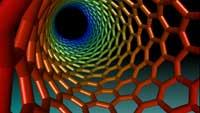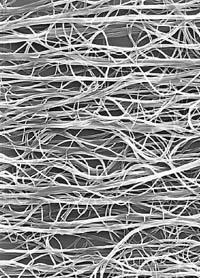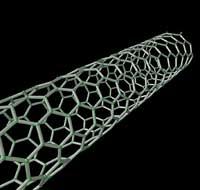Carbon nanotubes, muscles for robots
2009/04/12 Lakar Iraizoz, Oihane - Elhuyar Zientzia

The material is composed of a network of carbon nanotubes and an aerogel. Aerogeles are substances similar to rooms, but with a particularity. Gels are a kind of suspensions: they have a liquid phase and a solid; the solid is a group of particles. In the case of aerogeles, they replace the liquid with a gas, obtaining solids of very low density. Aerogeles are also called ice cream smoke.
Carbon nanotubes are tubes made up of carbon atoms. Also carbon graphite or pain of arches and diamond. The spatial arrangement of carbon atoms determines that a set of carbon atoms forms graphite or diamond.
In graphite, carbon atoms are layered and can be distributed. Scientists have known this for a long time, but a few years ago they began to use these layers individually. The thickness of the layers is of a single atom (the length and width can be unlimited), which brings very special properties to the material. For example, electricity flows easily through these layers. Electrons have no obstacles to advance in the layer and pass quickly with little resistance.
Due to its special properties, experts consider that it is another material, although it is one of the basic components of graphite, and have given it its own name: graphene. Thus, by rounding the graphene layers, scientists get carbon nanotubes. In rounding, the properties change in some way, since they are not flat, but carbon nanotubes remain good conductors, electricity easily passes by carbon.
Rapid contraction of artificial muscle
Scientists have made a sheet with the aerogel in which they have introduced nanotubes. They have put in a lot of nanotubes, like a forest of nanotubes. The sheet has a thickness of fifty one millimeter, a width of 16 centimeters and a length of several meters.

Carbon nanotubes are good conductors, electricity easily passes by carbon. (Photo: G. Hutchison
Scientists believe that with this type of foil they can make muscles for robots. Muscles only need electricity discharges to move.
Carbon nanotubes remain very good conductors, so movement is immediate. In fact, nanotubes move 4,000 times faster than human muscles.

Aerogeles are very low density solids in which carbon nanotubes were deposited in an aeroogel sheet. (Photo: NASA).
This eccentric muscle gives an answer or another about how they give the discharges. In the width of the sheet, that is, from side to side, when giving it, the width of the sheet is tripled. It seems that when discharging through carbon nanotubes, nanotubes are negatively charged and loads repel and tend to move away from each other.
However, scientists have found that applying the plate to length contracts. This causes an increase in the density of the material that makes it much harder. At that time it is proportionally harder than steel. In addition, it can act in a wide temperature range without losing properties, between -193 °C and 1,627 °C. Yes, superpowers!
Published in 7K.

Gai honi buruzko eduki gehiago
Elhuyarrek garatutako teknologia





